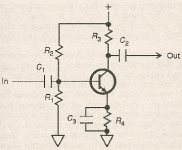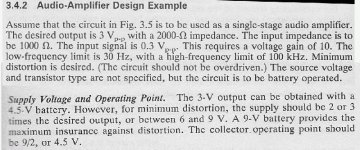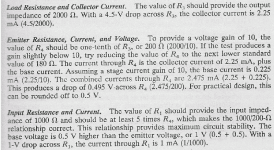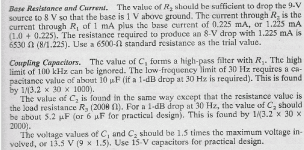Your imagination seems to precede the thinking process by a bit. Nothing wrong with imagination, but electronic circuits have two key aspects:
_-_-bear
Yeah, I am constantly bummed about how my imagination is limited by reality...
typical of modern youth that not only want to be spoon fed, they expect it as the norm.hmmm what I'm meaning to say is I don't want to design an amplifier... I just want to build one that works.. is that too hard of a task to ask for?
I've made an amplifier that works.. and it works good.. but could be just a tad bit better..
if I can fit that tad bit better into my amplifier then I would be all set and I wouldn't ask anymore questions.. I'd be a happy camper with my amplifier and I'd be listening to music whenever I want and I wouldn't have to worry about the DC flowing to my speaker anymore..
but the bit of DC is messing everything up so badly..
I think I've finally figured out what he meant when he showed the schematic of the resistor and capacitor together... I think that's it..
I will not assist in spoon feeding any Member.
'Seems a reasonable expectation but you'll have to learn how to do that on your own steam. The level of education in electronics needed is not rocket science - It's junior High School standard but there are many educational forums and websites on basic electronics that cover audio amplifiers and that is obviously what you need, if only to copy the circuit diagrams, learn the symbols and how components work together to best produce a result. Its free, you have access to a PC so why not get on with it?hmmm what I'm meaning to say is I don't want to design an amplifier... I just want to build one that works.. is that too hard of a task to ask for?
Google anything that comes into your head like "Basic Electronics" I came up with 12 sites offering on-line fun projects and advanced learning on the first page. There are hundreds. - It's all out there at a more helpful level than DIYAudio can offer you on a 1:1 basis, particularly if you want it in lego-blocks format rather than conventional electronic symbology and schematics.
Learn first, improve stuff along the way. If you then want to discuss ...SERIOUSLY...not as Lego block stuff, then we can help, as you will read in the help type threads here.
Last edited:
Simplified Audio Design
Here's a spoonful. Hopefully it won't go down like castor oil.
Acknowledgement to Lenk's Audio Handbook, 1st ed. by John D. Lenk
realflow100, I believe I speak for many when I say you should read this and demonstrate some understanding of the principles. You can apply this info to your transistor. We're simply asking for your input in return for our input.
Here's a spoonful. Hopefully it won't go down like castor oil.
Acknowledgement to Lenk's Audio Handbook, 1st ed. by John D. Lenk
realflow100, I believe I speak for many when I say you should read this and demonstrate some understanding of the principles. You can apply this info to your transistor. We're simply asking for your input in return for our input.
Attachments
realflow100, the circuit put up by sofaspud is the basic circuit that you want in as much as it is a single transistor, and gets rid of the DC. All you have to do is to make a power supply, pick the right power transistor and use approximately the right value resistors.
The neat part is that it will work.
Add just three more transistors and you can make a simple amp that will have more power and be what is called "push-pull". Do that after you get the first one made. Well, you have the first one made, so this would be the second, a push-pull your third.
Fyi, there are numerous other more simple descriptions and example of this circuit around, many online. So, just look at them, and you will start to see a trend and start to see how it works. Maybe even see a pictorial example or two.
As far as construction methods, look up "manhattan " style, and "dead bug" style, there are some others that will show up too.These are quick and dirty but effective ways to build circuits almost free, or free.
Whaddya say?
_-_-bear
The neat part is that it will work.
Add just three more transistors and you can make a simple amp that will have more power and be what is called "push-pull". Do that after you get the first one made. Well, you have the first one made, so this would be the second, a push-pull your third.
Fyi, there are numerous other more simple descriptions and example of this circuit around, many online. So, just look at them, and you will start to see a trend and start to see how it works. Maybe even see a pictorial example or two.
As far as construction methods, look up "manhattan " style, and "dead bug" style, there are some others that will show up too.These are quick and dirty but effective ways to build circuits almost free, or free.
Whaddya say?
_-_-bear
okay I put the resistor and the capacitor at the output and put my speaker to the capacitor and to the output and now the music quality is great and there's no more DC current flowing to my speaker!!
it works great!! thanks!
I'm very happy now!
the output has just a tad bit less bass but still way plenty loud enough
there's zero DC current flowing to my speaker when I wire my speaker up!
it pops out and then goes back in when I plug in the power supply
but the speaker doesn't stay popped out.. it goes back to it's resting place!! I'm sooo happy now!!
It works so great! and sound's amazing too!! probably one of the better sounding amplifiers I've ever heard!
I have AC coupled my amplifier and it seriously sounds great! and there is no more DC flowing to the speaker!! i'm so happy about that!
now I can play my music as long as I want without risking the life of my speaker!! woohoo!!
woohoo!!
but my transistor gets a tad bit warmer than before (probably because I need to use a different resistor or one that's closer to the right value since I'm merely guessing by choosing one that just sounds good enough... but I need one that's actually closer to the correct value that I need to make my amplifier sound the best.
I have two capacitors each 1000uF's in parallel so I get 2000uF's for the output to my speaker.. I wanted to use two 4000uF capacitors but couldn't find any.
and it was so simple once I figured it out.. I don't know why I went through so much trouble to do something so simple..
and yeah I'll check out those attachments.
so far I only have
two capacitors.
two resistors.
one transistor
and my speaker.. that's really simple!!!!!!
I'm also using only a 5 volt power supply right now..
it works great!! thanks!
I'm very happy now!
the output has just a tad bit less bass but still way plenty loud enough
there's zero DC current flowing to my speaker when I wire my speaker up!
it pops out and then goes back in when I plug in the power supply
but the speaker doesn't stay popped out.. it goes back to it's resting place!! I'm sooo happy now!!
It works so great! and sound's amazing too!! probably one of the better sounding amplifiers I've ever heard!
I have AC coupled my amplifier and it seriously sounds great! and there is no more DC flowing to the speaker!! i'm so happy about that!
now I can play my music as long as I want without risking the life of my speaker!!
but my transistor gets a tad bit warmer than before (probably because I need to use a different resistor or one that's closer to the right value since I'm merely guessing by choosing one that just sounds good enough... but I need one that's actually closer to the correct value that I need to make my amplifier sound the best.
I have two capacitors each 1000uF's in parallel so I get 2000uF's for the output to my speaker.. I wanted to use two 4000uF capacitors but couldn't find any.
and it was so simple once I figured it out.. I don't know why I went through so much trouble to do something so simple..
and yeah I'll check out those attachments.
so far I only have
two capacitors.
two resistors.
one transistor
and my speaker.. that's really simple!!!!!!
I'm also using only a 5 volt power supply right now..
Last edited:
hmmm what I'm meaning to say is I don't want to design an amplifier... I just want to build one that works.. is that too hard of a task to ask for?
I've made an amplifier that works.. and it works good.. but could be just a tad bit better..
if I can fit that tad bit better into my amplifier then I would be all set and I wouldn't ask anymore questions.. I'd be a happy camper with my amplifier and I'd be listening to music whenever I want and I wouldn't have to worry about the DC flowing to my speaker anymore..
but the bit of DC is messing everything up so badly..
I think I've finally figured out what he meant when he showed the schematic of the resistor and capacitor together... I think that's it..
Hi,
Your stubbornness in refusing to accept reality is disappointing.
Your amplifier does not "work good" and cannot be made "a tad better"
to work properly. You have been provided with the tools and means
to work this out for yourself, seems that your not interested.
For battery power up to 12V look at the guts of discarded car casette/radios.
About 4W into 4 ohm for a single chip and about 16W for bridged chips.
The car stereo will have the necessary heatsinking and all the bits.
e.g. :
http://www.classiccmp.org/rtellason/chipdata/ha1377.pdf
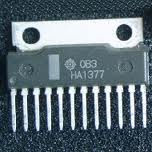

Bridged HA1377, 17W into 4 ohms
Stay the hell away from any mains powered equipment.
rgds, sreten.
Last edited:
"Stay the hell away from any mains powered equipment."
Real, did you catch that? Given what I continue to see in your responses, I think this is the best and most important advice you have received.....
In case you don't understand....if it plugs into the wall, don't mess with it....
Real, did you catch that? Given what I continue to see in your responses, I think this is the best and most important advice you have received.....
In case you don't understand....if it plugs into the wall, don't mess with it....
Are you sure the diagram matches the text? The emitter decoupler C3 should be omitted; it is not mentioned in the text. The text is a bit confusing about calculating coupling capacitor values. At the input it uses R1 instead of R1 in parallel with R2, and at the output it uses R3 instead of R3 in series with the output load (whatever that is). He assumes a beta of 10, which seems a bit low.sofaspud said:Here's a spoonful.
Perhaps this was in the introductory part of the book, so details were skipped over, but it could create as much confusion as it solves if people regard it as definitive.
Well, he said he was 15, but I suspect more like 11, 12 yo... just speculating.
By the time I was 15 I had built several Heathkits, including an SB-301 ham band SSB receiver, as well as duplicating a 6146 screen modulated transmitter (novice power, back in the day) from the ARRL handbook by myself.
My first scratch electronic project was a discrete transistor schmitt trigger that my father brought home the part for from an engineer at RCA in NJ where he worked at the time. It did not work. The engineer had made an error in the schematic. I used the Heathkit VTVM that I built to test its action. That was when I was 13, iirc.
But I suppose I had a natural talent for "stuff" so that helps.
I found a local ham who became my mentor, and he gave me my Novice test on his dining room table. He gave me all sorts of help, explanations and parts to complete the transmitter. Also, a ton of back issues of Electronics World, Popular Electronics and QST to read. Learning by doing and absorption.
Everyone is different, but that's how it went for me...
By the time I was 15 I had built several Heathkits, including an SB-301 ham band SSB receiver, as well as duplicating a 6146 screen modulated transmitter (novice power, back in the day) from the ARRL handbook by myself.
My first scratch electronic project was a discrete transistor schmitt trigger that my father brought home the part for from an engineer at RCA in NJ where he worked at the time. It did not work. The engineer had made an error in the schematic. I used the Heathkit VTVM that I built to test its action. That was when I was 13, iirc.
But I suppose I had a natural talent for "stuff" so that helps.
I found a local ham who became my mentor, and he gave me my Novice test on his dining room table. He gave me all sorts of help, explanations and parts to complete the transmitter. Also, a ton of back issues of Electronics World, Popular Electronics and QST to read. Learning by doing and absorption.
Everyone is different, but that's how it went for me...
No Cal, we are warning a 15y/o newbie NOT to mess with mains or even consider it....
I am aware of that. It was just a 'gentle' reminder from

Direct mains powered equipment discussion is not allowed here.
If this route is being considered, the thread will be closed
and your posting privileges revoked.
It's that serious.
Hi,
Not the issue under discussion. Wall wart powered is OK for a newbie.
Mains powered is not IMO until some proper understanding is exhibited.
Direct mains powered was not mentioned, don't give people ideas ...
rgds, sreten.
okay I found a bunch more capacitors and I upped the total rating of them all combined to 7200uF's!!
that's quite a bit..
It sure made a big difference!! my subwoofer is causing a mini earthquake! and the low frequencies get down to like 2-4hz!
Hi,
Please stop spouting nonsense about your build.
Realise you have no idea what the output bias point is, the input impedance is,
the frequency response is, the output power is (very low), and that you could
build something far better if you took any of the sensible advice available.
Your speaker can do nothing like 2 to 4Hz at any useful level.
How to build a decent speaker that works properly is another can of worms
you no doubt also want to pretend you don't need to know, but you do.
rgds, sreten.
- Status
- This old topic is closed. If you want to reopen this topic, contact a moderator using the "Report Post" button.
- Home
- Amplifiers
- Solid State
- I just designed an amplifier to power big speakers with small voltage!
